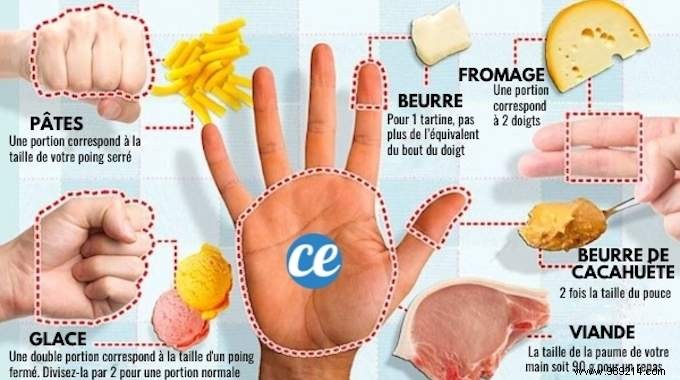
Trying to lose weight?
Today, I present to you an easy method to calculate the right food portions.
What's great about this trick is that it's extremely simple.
Thanks to this method, you no longer have to measure all your ingredients with a kitchen scale or a measuring cup.
You calculate all of your food portions using only your fingers, thumbs, and the palm of your hand .
This guide shows you the exact quantity what you should eat for each food and per meal . And as you will see...
The right portions for weight loss are surely much smaller than you think! Watch:
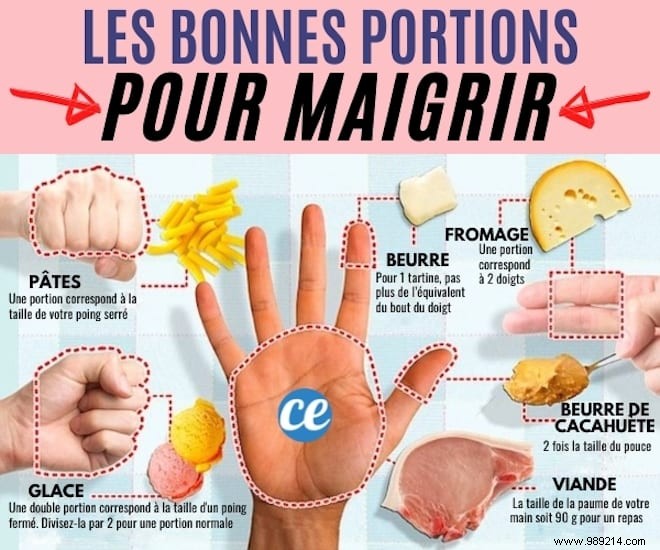
Recent studies have shown that over the past 20 years, food portions have doubled in size.
For example, many people eat up to 5 TIMES the recommended serving of pasta!
Do you tend to pour out the whole package of pasta when cooking?
So, I'm warning you, this handy guide to measuring your food might get you down.
More seriously, this guide will help you lose weight, thanks to the "Diet that fits in your hand".
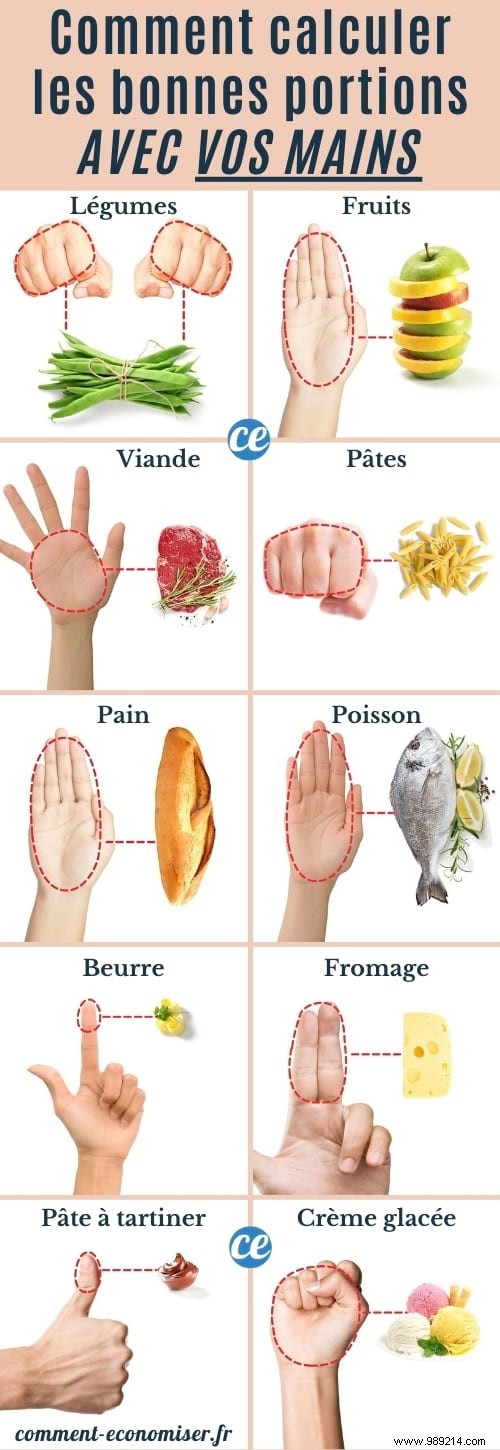
Click here to easily print this guide in PDF.
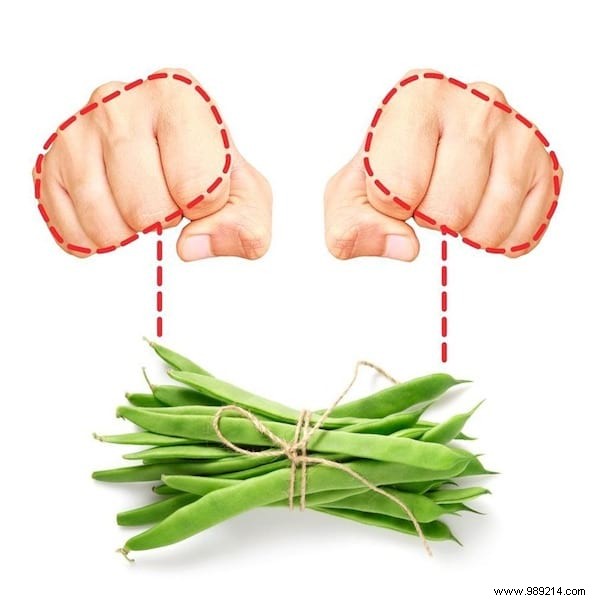
The right portion of vegetables fits your two clenched fists. Of course, vegetables are not problematic in terms of calories so you can eat as many as you want.
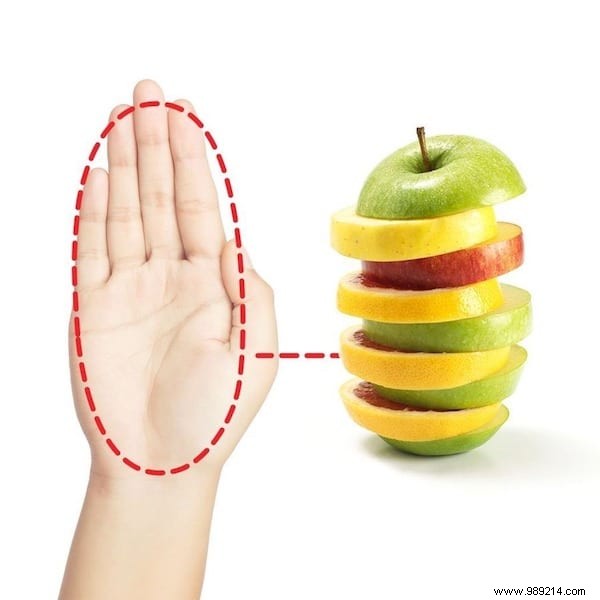
The correct portion for a fruit is the size of your whole hand. The ideal portion is approximately 100 g. In any case, do not deprive yourself of fruit!
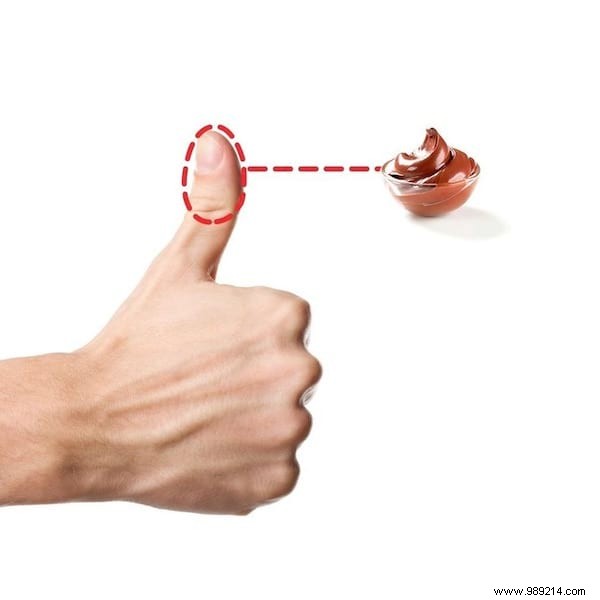
The right portion not to exceed for spread is equivalent to the knuckle of a thumb. It is not advisable to eat spreads like Nutella every day. But if you want to indulge yourself, do not exceed this amount.
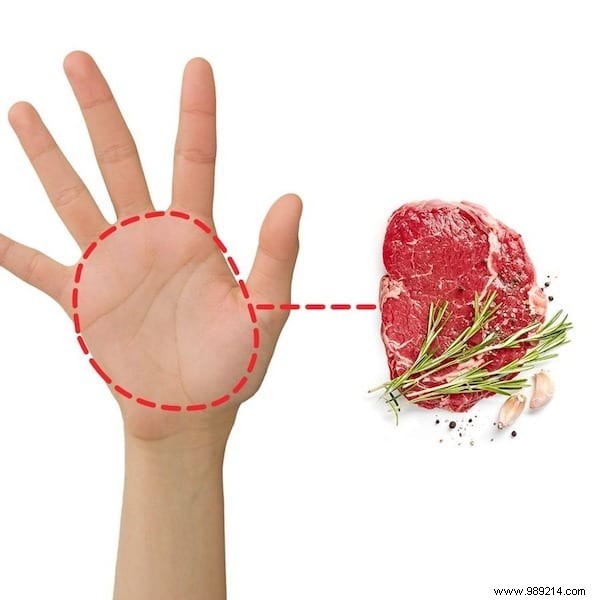
The right portion of meat not to exceed should fit the palm of your hand. It corresponds to a frozen ground beef for example. In any case, know that you should not exceed 500 g of red meat per week. Remember to favor white meat, rather than red meat.
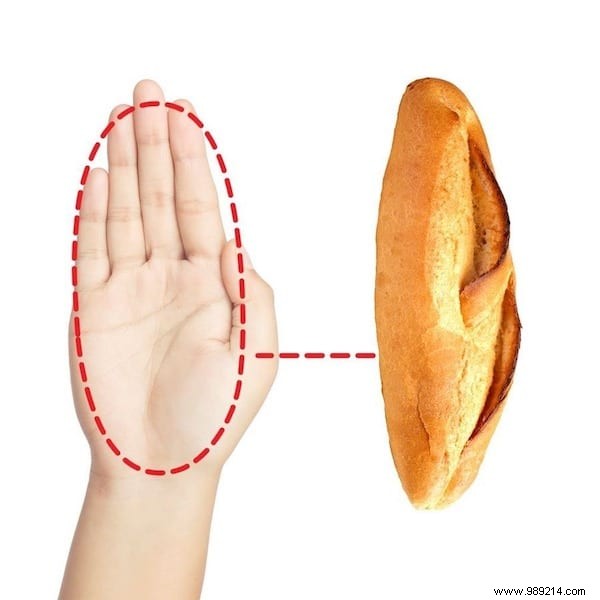
The right portion of bread is easy to stick to. Do not eat more than the equivalent of your open hand from the bottom of the hand to the fingertips. Be careful not to combine starchy foods! If you also eat pasta, the sum of the two quantities should not exceed the palm of your hand.
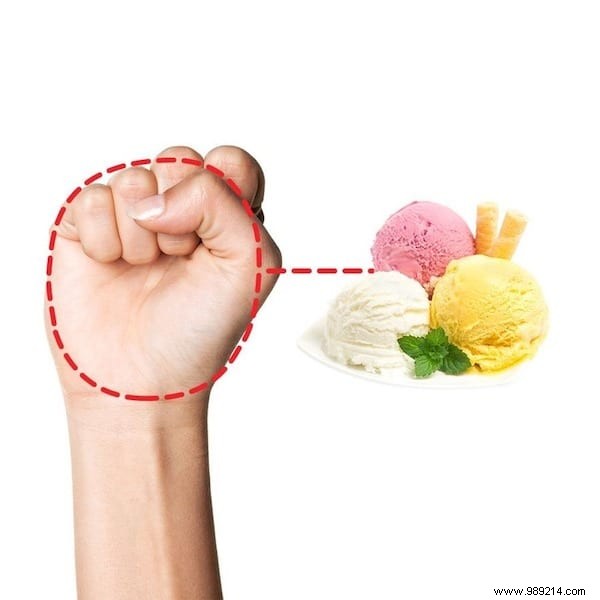
Obviously, ice cream should not be eaten every day! But if you want to indulge yourself from time to time, you should not exceed a closed fist, or even divide this quantity by two.
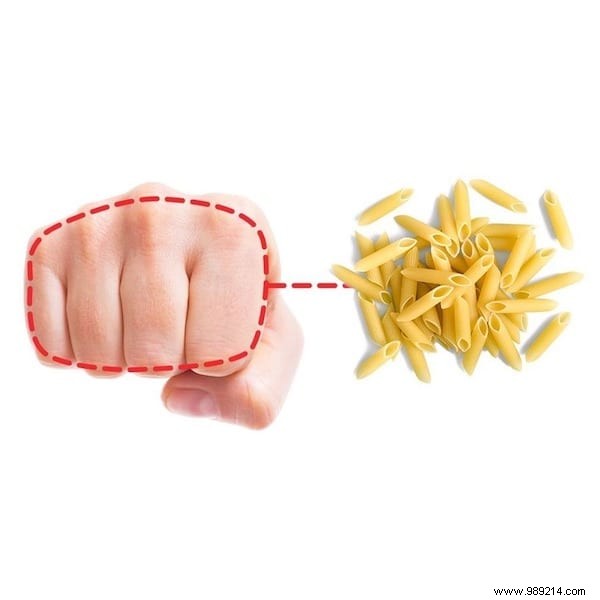
The right portion of pasta to consume represents the equivalent of a clenched fist for a person. It is surely much less than what you are used to eating! So be careful not to exceed this amount to lose weight.
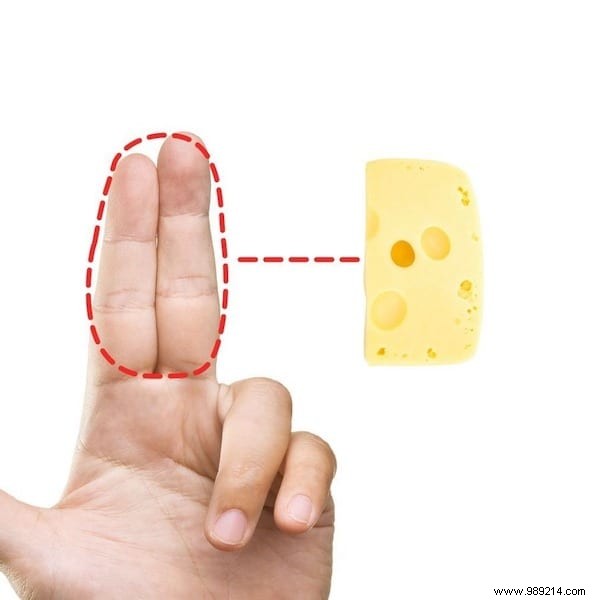
The right portion for a daily piece of cheese is the equivalent of 2 fingers, or 30 g. And if you want to eat yogurt, don't eat more than 125g.

The correct daily portion for butter should not exceed the knuckle of your index finger. This is important for losing weight, because butter is obviously very fatty.
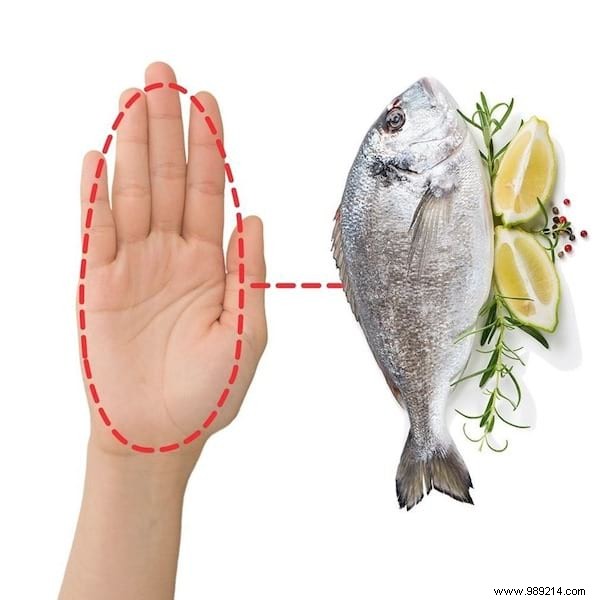
The right portion for fish is the equivalent of the palm open to the sky. It is advisable to eat it twice a week, avoiding the fish listed here.
According to experts, eating too large portions of food is one of the main causes of overweight.
Indeed, many people eat much more than they should.
Take meat, for example. Know that a portion of meat should not exceed the palm of your hand.
And for pasta and other carbs, the serving size should fit into a clenched fist.
How much butter to put on your toast? No more than the equivalent of a fingertip.
All of this information comes from the Guard Your Health site.
According to nutrition experts, far too many people eat too large portions on a regular basis.
This is particularly the case with pasta, where some people eat up to 5 times the recommended portion.
According to studies, even when we are served too big portions, we tend to eat them.
This is surely due to the famous "empty plate syndrome".
That is, that mentality with which we were brought up to "clean the plate" to avoid waste.
Researchers have also found that cookies are up to 7 times the recommended size.
Muffins are up to 3 times the weight of a recommended serving.
Martin and Marion Shirran are psychotherapists and nutrition specialists.
In their book, "The Gastric Mind Band ", they give heartbreaking examples of the importance of proper portion measurement.
In particular, they detail the huge impact that portion size can have on weight loss:
"When you spread a thin layer of butter on your bread, that's the size of a teaspoon. Altogether, that's 37 calories.
"But if you spread a generous layer, a tablespoon, that's three times the calories (111 calories).
"When making a dressing for your salad, learn to reduce the amount of oil.
"In fact, a teaspoon of vegetable oil contains up to 45 calories, while a tablespoon contains 135.
"So, a 'small' extra tablespoon of oil each day leads to considerable weight gain within a year.
"Similarly, try as much as possible to substitute sugar to sweeten your cup of tea or coffee.
“Suppose you cut out the 2 scoops of sugar you put in your tea 3 times a day.
"That would reduce your annual calorie intake by 37,000 calories. That's often enough to lose more than 5 pounds."
"You can eat ice cream once in a while. But limit yourself to one scoop (about 150 calories), and never eat it straight from the jar.
"You can also snack on nuts. But don't overeat them, as a small 120g packet contains up to 600 calories."
Many cardiovascular disease prevention organizations have already sounded the alarm.
According to them, supermarkets have lost all control when it comes to portion sizes.
In fact, despite a steadily worsening obesity crisis, portion sizes continue to increase.
In fact, in just 20 years, some portions have even doubled!
Take, for example, cooked chicken dishes. These have increased by 53% in size, compared to 20 years ago.
Shepherd's pie ready meals have almost doubled in size.
Pastries increased by 20-30% in size.
Know that it is enough to increase your calorie intake by only 3,500 calories to gain 500 g!
Massive increases in portion sizes are a big part of why so many people are gaining weight.
And this, without knowing it or wanting it! But that's not all...
According to health organizations, increasing portion sizes also contributes to the risk of cardiovascular disease.
And as a reminder, heart disease is the second leading cause of death in France.
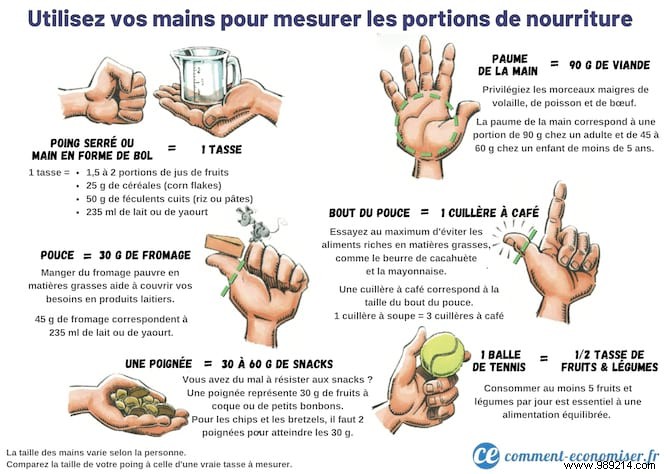
Click here to easily print this guide in PDF.
Clenched fist or bowl-shaped hand =1 cup
1 cup represents:
- 1.5 to 2 servings of fruit juice
- 25 g of cereals (corn flakes)
- 50 g of cooked starch (rice or pasta)
- 235 ml of milk or yogurt
One inch =30g of cheese
Eating low-fat cheese helps meet your dairy needs.
45 g of cheese corresponds to 235 ml of milk or yoghurt.
A handful =30 to 60 g of snacks
Having trouble resisting snacks?
Know that a handful represents 30 g of nuts or small candies.
For crisps and pretzels, it takes 2 handfuls to reach 30g.
Tip of the thumb =1 teaspoon
Try to avoid high-fat foods as much as possible, such as peanut butter and mayonnaise.
A teaspoon is the size of the tip of your thumb, from the knuckle to the tip. One tablespoon contains 3 teaspoons.
Palm of the hand =90 g of meat
Choose lean cuts of poultry, fish, shellfish and beef.
The palm of the hand corresponds to a portion of 90 g in an adult. In a child under 5 years old, this corresponds to between 45 and 60 g.
1 tennis ball =1/2 cup of fruits and vegetables
Consuming at least 5 fruits and vegetables a day is essential for a balanced diet.
Note: Hand size varies by person. Thus, it is recommended to compare the size of your fist to that of a real measuring cup.